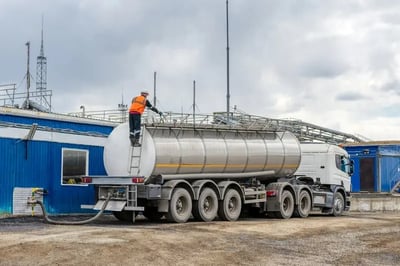
You can’t manage what you don’t measure, and what you don’t manage eventually comes back to bite you—and eat away at profits. Fleet managers know that you can’t save what you don’t measure. Accounting for every drop of fuel spent is essential for profitability and accurate reporting. It doesn’t matter how much or where the fuel is being dispensed––whether it’s to a truck at a local tank or jerrycans at remote sites, every drop matters.
In the first of this three-part blog series, we looked at the issues that arise with the manual reconciliation of primary storage tanks. This second part examines neglected assets further down the operations line and smaller assets.
TRACKING OFF-SITE FLEET FUELING: TOP 4 ISSUES
1- Fuel Shrinkage with storage tanks
Fuel shrinkage is a fact of fleet operations. Ideally, the target for remote operations is to keep shrinkage below 2%. Some types of fuel shrinkage are unavoidable due to ambient temperature fluctuations. There is a 1% change in the volume of gasoline for every 10 degrees C or 19 degrees F change in temperature. Fleet managers accept this and understand that it is impossible to have numbers match precisely.![]()
Shrinkage can also occur due to dispensing fuel to unauthorized equipment or outright theft. For remote construction and mining sites, fuel storage tanks and day tanks are scoped by thieves who will steal fuel at night or on the weekend when your operations team is not around. Theft is easier to control at permanent fuel dispensing stations. The installation of a sound automated fuel management system restricts unauthorized dispensing of fuel and tracks all transactions for accurate reconciliation. In addition, you can install security lighting and cameras to monitor your yard 24/7.
However, such measures are often not an option for remote sites. Sometimes, no network is available, rendering traditional fuel management systems practically useless. And sometimes, the small size of storage tanks and/or slip tanks makes such systems cost-prohibitive and unattractive to fleet operators.
So, fleets often rely on manual logs and data entry when it comes to tracking fuel at remote sites. Of course, in this scenario, missing data and entry errors are a constant thorn in the side of a fleet manager, and fuel shrinkage becomes a very costly part of the fleet's operational reality.
2- Operational Friction in Your fleet
Operational friction involves anything that slows down your company’s daily operations. When efficiently managing your fleet’s fuel, accurate and timely data is required from your field personnel. Here is where the friction occurs: manually capturing the needed information slows down daily refueling processes.
Accurate record-keeping is tedious, difficult to perform in harsh ambient conditions, and a nuisance to the operator. Any documented records must be forwarded to the office for review and analysis. This often involves re-entry of manually written records into either a spreadsheet or an application. This process requires an extensive investment of man-hours to track what is happening in the field with high accuracy and confidence. And this is when manual records are actually kept!
Manual tank dips of your day tanks or remote fuel storage tanks is a procedure that can often be omitted. When project and delivery deadlines are paramount, the importance of good record-keeping and reporting decline. Sometimes, even the most basic manual tracking is set aside to eliminate perceived operational friction.
3- Fleet Fuel Supply
Nothing is more damaging to a company’s bottom line than having production or work come to a grinding halt because operations ran out of fuel. Fuel outages rob your company’s bottom line. Missed deadlines can result in late penalties and fines.
Imagine a situation involving a construction company. What happens when a remote fuel storage tank runs dry? Stationary equipment, from cranes, loaders and bulldozers, to gas generators that power smaller equipment, will cease to operate. You must then cope with lost production time and pay your crew on site while you wait for the fuel to be delivered. Remote fueling operations often lack the sophistication of proper instrumentation and monitoring to alert low inventory situations, which increases the risk of fuel outages.
Why your operations may run out of fuel is often attributed to the lack of daily manual dips of the site’s storage or day tanks. The person responsible for the daily dips either forgets to perform the task or may be absent from work for a couple of days. It is therefore easy to understand how your operations can run out of fuel.
4- Fleet Safety
One area linked to fuel supply but often overlooked is safety. When heavy equipment or generators in remote work environments run out of fuel, personnel on-site can be left in a precarious position. Loss of fuel could mean loss of essential hydraulic lift capabilities or other functions, such as lighting. Injury resulting from such scenarios must be avoided at all costs.
Safety also becomes an issue when no automated system is in place to manage the pumps properly. This becomes an issue when a piece of equipment has a fill pipe for diesel and another close to it for a different product—hydraulic fluid, for instance. Imagine the danger of mistakenly adding diesel to the hydraulic system. Not only can this cause expensive damage to your equipment, but the failure of your hydraulics can also cause severe injury—or much worse. An automated fuel management system would prevent that type of costly and potentially tragic mistake. But when everything is done manually, that type of error becomes a real possibility.
Why is Diligent Fleet Fuel Tracking So Difficult?
Many obstacles exist to diligent manual record-keeping. The first is the environment itself. Working in remote areas often means working in harsh environments. Workers are subject to a variety of weather conditions that can change quickly. Rain, freezing rain, snow, excessive heat and high winds make the job of refueling and daily fuel tank reconciliation unpleasant and often dangerous. No one wants to slip off equipment or lose their footing during fueling operations. No one wants to be exposed to extremely harsh weather conditions. Routine manual tank measurements and fueling records often get fudged during severe weather conditions.
Imagine fueling a heavy piece of equipment where the operator and site foreman are voicing their displeasure over the time the fueling process takes when the equipment and other information need to be recorded. The fueler will tend to rush observed readings or fail to record them, creating inaccurate information. A rushed job presents a greater risk of errors. This information needs to go somewhere. Usually, paper records are compiled at the local office, where someone needs to key this data into a spreadsheet or management software manually. Duplicate data entry is time-consuming and tedious and creates an opportunity for other data entry errors.
information. A rushed job presents a greater risk of errors. This information needs to go somewhere. Usually, paper records are compiled at the local office, where someone needs to key this data into a spreadsheet or management software manually. Duplicate data entry is time-consuming and tedious and creates an opportunity for other data entry errors.
Many fleets are incorporating mobile fuel fueling software to track fuel consumption. However, many software and hardware fuel management packages lack the sophistication needed to automate the record-keeping of fuel dispensed. Often, the operator must walk back and forth from the fuel truck to the asset to record information, creating additional frustration. They must key in information for each asset, their specific identification number, time, dates and other information. In reality, the frustrations and operational friction inherent with paper record-keeping are transferred to an electronic system that provides little relief.
To Be COntinued...
Now some good news: we are done with the gloom and doom. We have listened to and worked with fleet managers for over 30 years. We have documented the friction points communicated to us and created automated solutions to streamline data collection, record keeping and reporting.
We invite you to check out the final blog in this three-part series for a deep dive into how you can automate the fuel inventory reconciliation process through Coencorp's advanced fleet fuel inventory management solutions. It is coming out very soon, so stay tuned!
